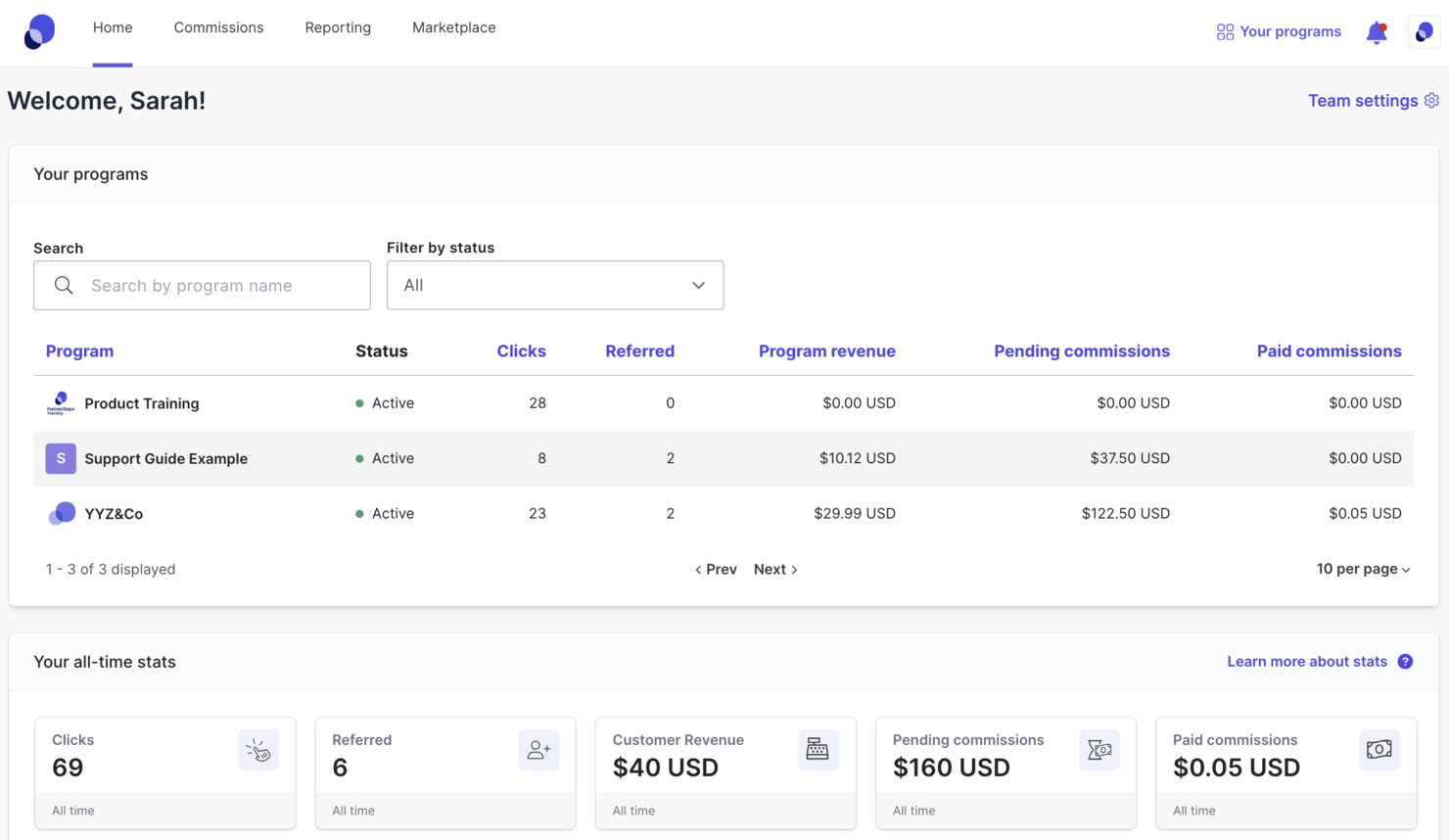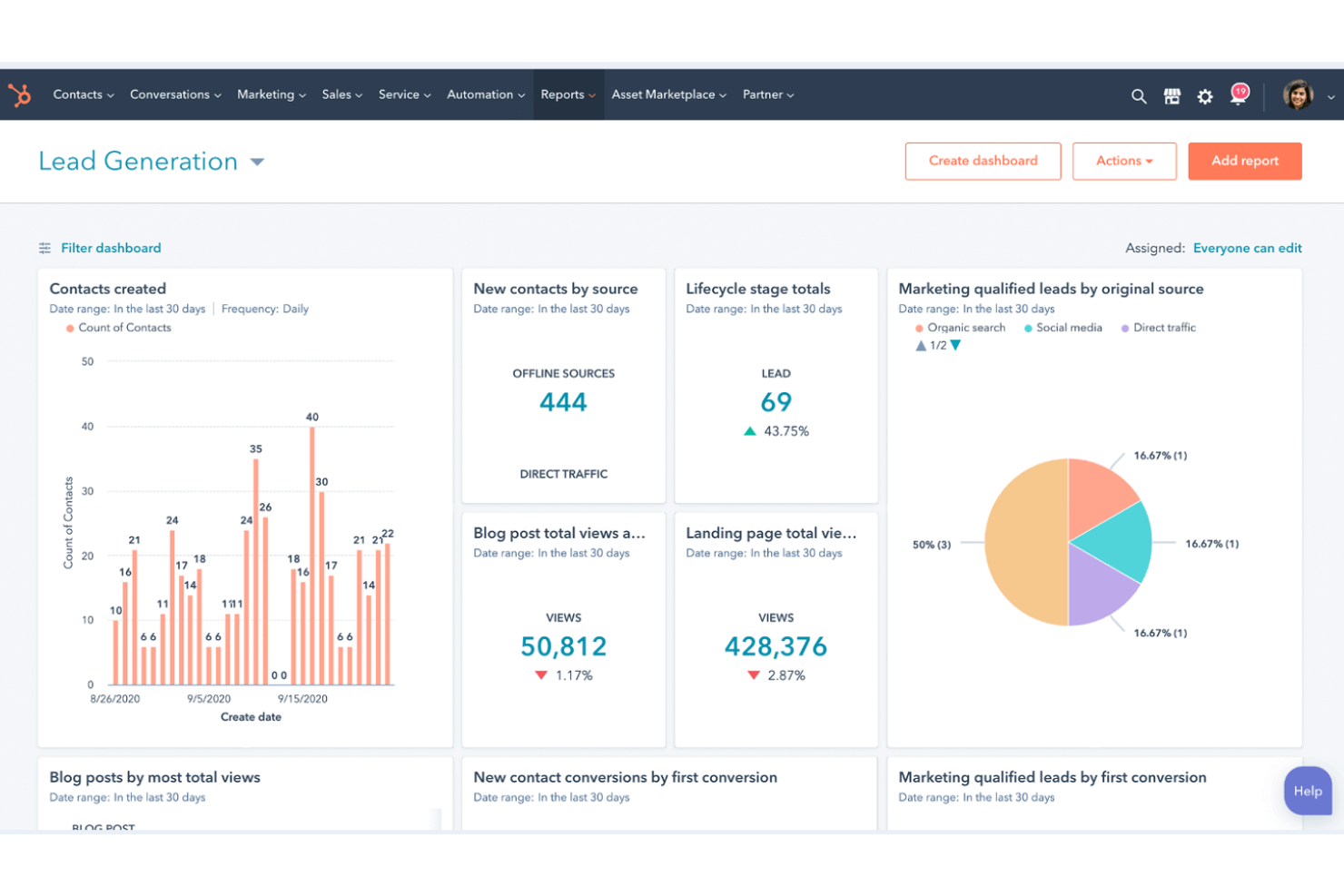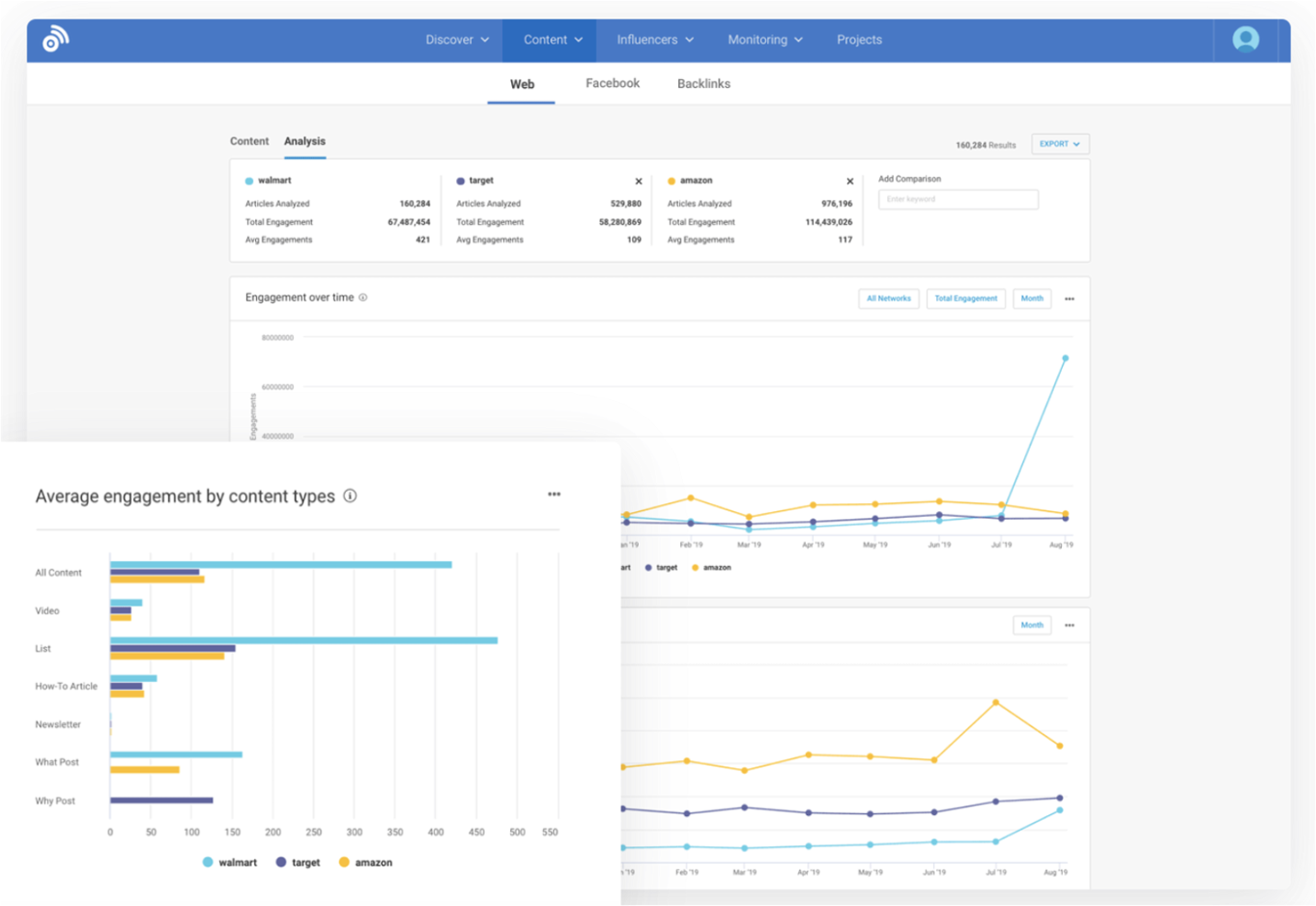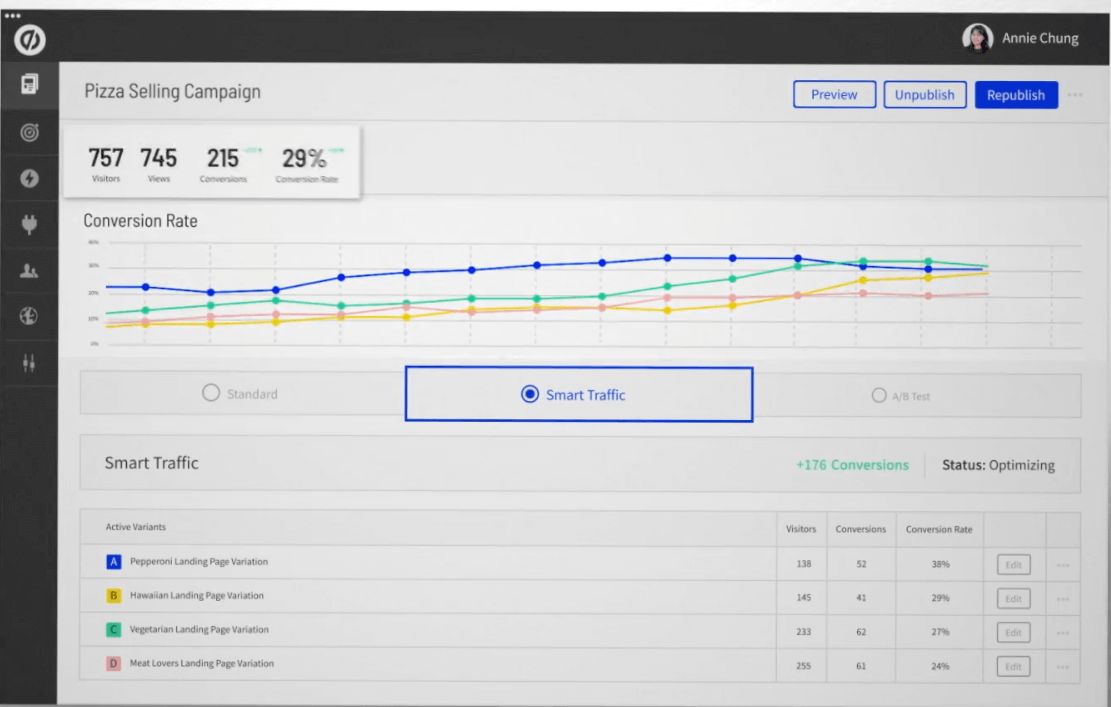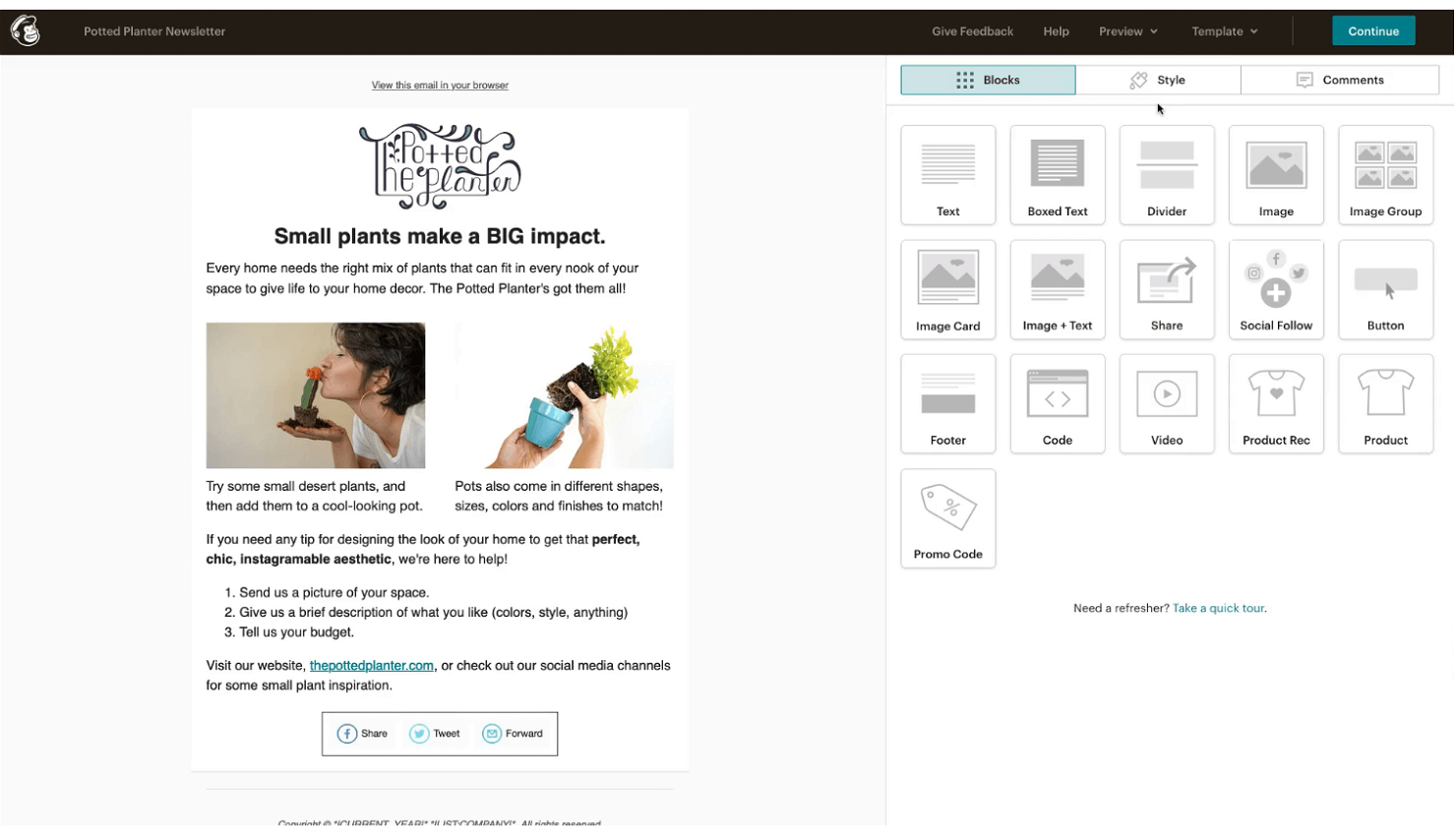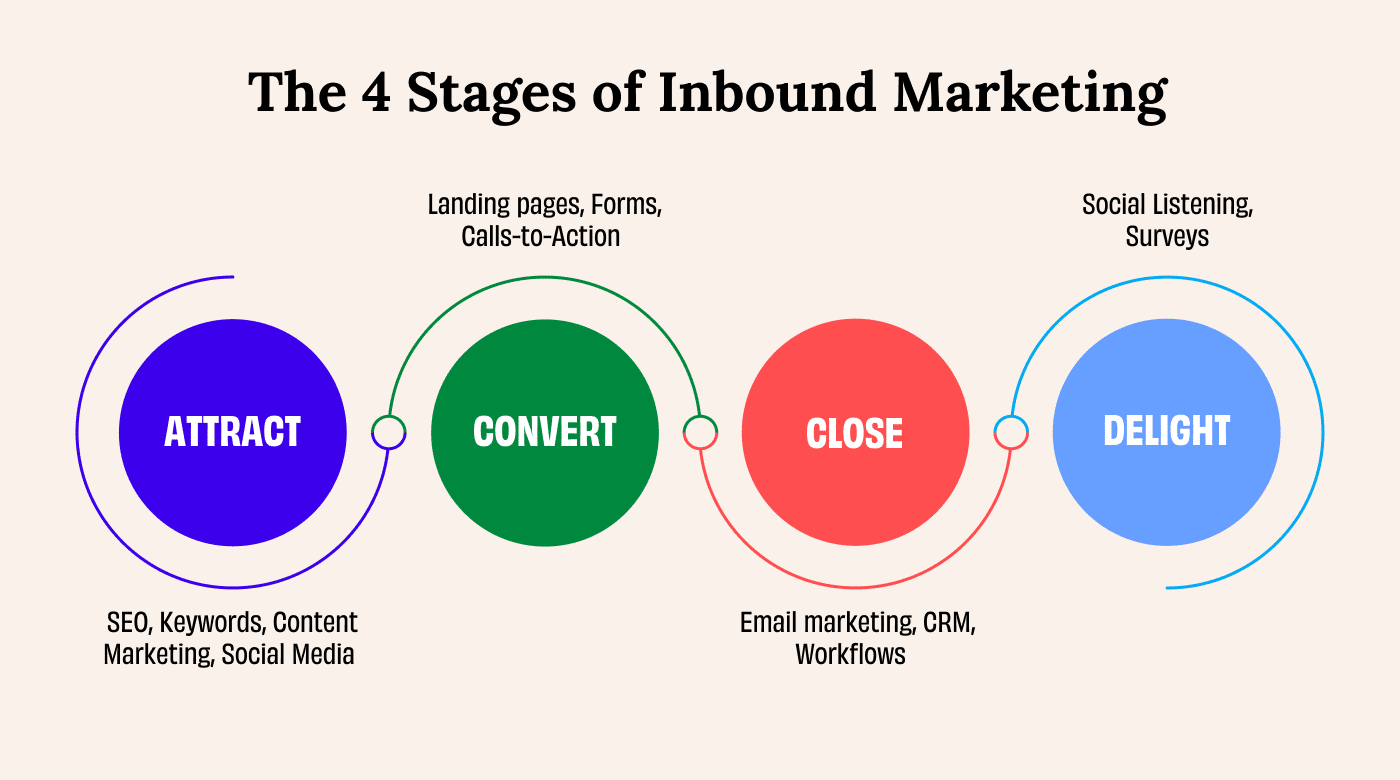10 Best Inbound Marketing Tools Shortlist
Here's my pick of the 10 best software from the 23 tools reviewed.
With so many different inbound marketing tools solutions available, figuring out which is right for you is tough. You know you want tools to create valuable content tailored to their target audience, enhancing their online presence and drawing potential customers to your website—but now need to figure out which solution is best. I've got you! In this post, I'll help make your choice easy, sharing my personal experiences using dozens of different inbound marketing software with companies of all sizes, with my picks of the best inbound marketing tools overall.
Why Trust Our Reviews
We’ve been testing and reviewing marketing software since 2022. As marketing experts ourselves, we know how critical and difficult it is to make the right decision when selecting software.
We invest in deep research to help our audience make better software purchasing decisions. We’ve tested more than 2,000 tools for different marketing use cases and written over 1,000 comprehensive software reviews. Learn how we stay transparent & our software review methodology.
The Best Inbound Marketing Tools Summary
| Tools | Price | |
|---|---|---|
| PartnerStack | Pricing upon request | Website |
| HubSpot Marketing | From $800/month + $45/month for additional seats | Website |
| Survicate | From $59/month | Website |
| BuzzSumo | From $95/month when billed annually | Website |
| SurveyMonkey | From $25/user/month (billed annually) | Website |
| Unbounce | From $99/user/month | Website |
| Mailchimp | From $13/month | Website |
| Hootsuite | From $49/user/month (min 3 seats, billed annually), Hootsuite's pricing reflects its position as a professional-grade tool for social media management. | Website |
| Campaigner | From $59/month | Website |
| Typeform | From $29/user/month | Website |

Compare Software Specs Side by Side
Use our comparison chart to review and evaluate software specs side-by-side.
Compare SoftwareHow to Choose Inbound Marketing Tools
When selecting software for your business, especially when considering a specialized tool such as inbound marketing tools, it's essential to approach the decision with a strategic mindset. Here’s a checklist that balances general software selection principles with specific considerations for marketing attribution software:
- Identify Your Business Needs: Clearly define what you need from an inbound marketing tool. Consider aspects like lead generation, content management, SEO, social media management, email marketing, analytics, and customer relationship management (CRM). The software should help you streamline these functions and enhance your marketing efforts.
- Usability and Learning Curve: Evaluate the user interface and ease of use. A tool that is intuitive and user-friendly for your team will reduce training time and increase adoption rates. Consider the available support and training resources to help your team get the most out of the software.
- Integration Capabilities: The software should easily integrate with other tools and systems your business currently uses, such as your CRM, ecommerce platform, social media, and analytics tools. Seamless integration ensures a unified approach to your inbound marketing strategy and prevents data silos.
- Scalability: Choose software that can grow with your business. It should be flexible enough to accommodate increased workload and additional users without significant upgrades or changes. Consider whether the tool can handle expanding marketing campaigns and a growing customer base.
- Features and Functionality: Assess whether the tool offers all the features and functionalities you need for your inbound marketing efforts. Look for advanced features like automation, personalized content capabilities, lead scoring, and detailed analytics. Ensure the software supports your inbound marketing strategy effectively.
- Compliance and Security: Verify that the software complies with relevant regulations and standards, especially if you handle sensitive customer data. Look for features that ensure data security, privacy, and GDPR compliance if applicable.
- Cost Effectiveness: Analyze the pricing structure and assess whether the investment aligns with your budget and expected ROI. Consider both upfront costs and ongoing expenses, including subscriptions, maintenance, and any additional features that may incur extra charges.
- Customer Support and Services: The availability and quality of customer support can significantly impact your experience with the software. Look for providers that offer reliable, accessible support through multiple channels and have a strong reputation for customer service.
- Vendor Reputation and Reliability: Research the vendor's track record and stability in the market. Read reviews and case studies from other businesses similar to yours to gauge the software's performance and the vendor's industry expertise.
- Trial and Demos: Before making a final decision, take advantage of free trials or demos offered by the software providers. This allows you to test the tool's functionality, user experience, and compatibility with your business operations firsthand.
By considering these factors, you can select an inbound marketing tool that not only meets your current needs but also supports your business's long-term growth and success.
Best Inbound Marketing Tool Reviews
For each tool I’ve reviewed, I’ve included the noteworthy features that make it stand out, listed the pros and cons of each, and included images to help you understand whether each tool is right for you.
PartnerStack is a powerful platform designed to help businesses manage and scale their partner programs, encompassing affiliate, referral, and reseller strategies. It offers a suite of tools to streamline partner onboarding, automate payouts, and provide comprehensive analytics to track performance.
Why I picked PartnerStack: One key feature that stood out to me is the automated partner onboarding process, which simplifies the integration of new partners into your program, ensuring they are quickly set up and productive. This efficiency not only saves time but also ensures that partners can start generating referrals and affiliate traffic without delay.
Additionally, PartnerStack's detailed performance analytics provide insights into which partners are driving the most value, allowing businesses to refine their strategies and maximize their inbound marketing efforts.
PartnerStack Standout Features and Integrations
Features include a user-friendly dashboard, automated partner payments, customizable commission structures, comprehensive reporting tools, and support for multi-tiered partner programs.
Integrations include Salesforce, Stripe, HubSpot, Slack, Recurly, Chargebee, Pipedrive, Google Sheets, and more.
Pros and cons
Pros:
- Ability to manage multiple affiliate programs in one place
- Automated notifications and payments
- Advanced tracking features
Cons:
- Potential learning curve for new users
- Limited payment methods available
Hubspot is a marketing CRM that helps you attract the right audience, convert more visitors into customers, and run complete inbound marketing campaigns at scale — all on one powerful, easy-to-use platform.
Why I picked HubSpot Marketing: One of its core strengths is its ability to create and manage high-quality content. With its integrated blog platform, marketers can easily draft, optimize, and publish posts that are search engine optimized, driving organic traffic to their websites. Additionally, HubSpot's content strategy tool helps identify and prioritize content topics that resonate with target audiences.
I also like HubSpot's lead nurturing capabilities, which are enhanced by its CRM integration. Through its marketing automation tools, businesses can create personalized email workflows that guide prospects through the buyer’s journey. The CRM integration allows for precise audience segmentation based on real-time data from customer interactions and behavior.
HubSpot Marketing Standout Features and Integrations
Features include marketing automation, lead management, calls-to-action, CRM integration, website SEO, video, live chat, and blog.
Integrations include Asana, Mailchimp, Slack, Zapier, Microsoft Dynamics, Shopify, WordPress, Salesforce, Google Analytics, QuickBooks, and hundreds more.
Pros and cons
Pros:
- Free plan has limited functionality
- Can get pricey with more advanced features
- Good automation capabilities
- Integrates marketing, sales, and CRM tools
- Intuitive platform
Survicate is a survey software designed to assist businesses in collecting user research and feedback across various channels. It is recognized for its effectiveness in gathering in-depth insights, which is essential for understanding customer experiences and improving products or services, thereby justifying its position as a top tool for user research and feedback.
Why I picked Survicate: I chose Survicate as an inbound marketing tool after evaluating its capabilities in gathering user feedback through its survey software. Its user-friendly interface and customizable survey options make it distinct in the market. I believe Survicate is best for user research and feedback because it enables businesses to collect valuable insights and measure Net Promoter Score (NPS), which is crucial for refining marketing strategies.
Survicate surveys can be used to measure key satisfaction metrics such as Net Promoter Score (NPS), Customer Satisfaction Score (CSAT), and Customer Effort Score (CES). They can also be tailored using various templates, and can feature custom logos, brand colors, and messages to maintain brand consistency across surveys.
Survicate Standout Features and Integrations
Features include a drag-and-drop creator for survey creation, a centralized feedback hub, automated feedback collection, real-time analytics to understand survey responses at a glance, and email embedding. I also like that Survicate uses advanced targeting to show surveys when users are most likely to answer, such as after a certain action is taken on a website or at a specific point in the customer journey.
Integrations include ActiveCampaign, Drip, Amplitude, HubSpot, Intercom, Mailchimp, Salesforce, FullStory, Zendesk, and Microsoft Teams.
Producing a constant stream of engaging content tailored to your target market can be challenging for any marketer. A tool like BuzzSumo is great at finding new topics and keywords, helping you overcome writer’s block.
Why I picked BuzzSumo: With an index of 8 billion articles to inspire your content, BuzzSumo is a powerful tool for content marketers and PR professionals. Two of BuzzSumo’s key areas — content discovery and content research — help you discover trending, evergreen, content ideas and filter what resonates with your audience so you never run out of inspiration.
The platform can also monitor your brand mentions, competitors, and industry updates, ensuring you alway stay on top of your competition. For example, you can enter a competitor’s domain to find their most shared content and use that information to inform your own strategy.
BuzzSumo also connects you to influencers and journalists with genuine authority on social media, who can promote your content and get you in front of a larger audience.
BuzzSumo Standout Features and Integrations
Features include content discovery, content research, identifying influencers, monitoring mentions, trends, and updates, BuzzSumo Chrome Extension, and
Integrations include Adverity, Buffer, Facebook, Hootsuite, Klipfolio, LinkedIn, Majestic, Reddit, Slack, and Twitter. BuzzSumo’s API also provides you with a wealth of resources ideal for things like building internal reporting tools or tracking your content’s performance.
Pros and cons
Pros:
- Powerful content discovery toolkit
- Connects you with influencers and journalists
- In-depth competitor analysis
Cons:
- No content creation features with basic version
- Content analysis doesn't include popular platforms like YouTube, TikTok, and Instagram
Thoughtful surveys that gather customer feedback are a great way to understand your customers and ensure they’re happy, satisfied, and supported. With over 17 million active customers and counting, SurveyMonkey is a global leader in survey software, helping you create, send, and analyze surveys.
Why I picked SurveyMonkey: With over 260 expert-written surveys, it helps you create the ideal survey for any occasion and customize them to your brand. It even helps you ask your customers the right questions using AI-powered guidance, and helps you interpret their answers using analytics tools.
If you opt for their specialized products, like SurveyMonkey Audience, you get access to an audience of 175M+ people, so you can conduct market research and get targeted responses in minutes.
SurveyMonkey Standout Features and Integrations
Features include over 260 expert-written templates, response analysis and built-in reports and dashboards, AI-powered guidance, and a SurveyMonkey Audience tool for collecting valuable market insights.
Integrations include BoldBI, Freshteams, Google Drive, HubSpot, MailChimp, Marketo, Microsoft Teams, Oracle, Salesforce, and Zapier.
Pros and cons
Pros:
- Analytics help you interpret survey results
- You can reach a large audience
- Templates make creating surveys easy
Cons:
- Some users may want more advanced question types
- Advanced features require a paid subscription
Unbounce is a great tool for building sleek, high-converting landing pages that reflect your brand.
Why I picked Unbounce: Unbounce lets you create, test, and optimize landing pages without any coding skills. It has a collection of over 100 high-converting landing page templates you can choose from and edit to fit your campaign goals. The tool also has a Smart Copy feature that helps you come up with engaging copy for your landing pages. Smart Copy uses AI to write persuasive landing page copy for you in seconds, so you save time and focus on other tasks.
Unbounce also sends your website visitors to the page that’s most likely to convert them. The Smart Traffic feature is better than traditional A/B testing because it uses AI to automatically optimize landing pages for you, letting you create as many variants as you need for each type of visitor.
Unbounce Standout Features and Integrations
Features include landing page builders designed for both new users or pros with coding experts, 100+ landing page templates, AI-generated copywriting for pages, ads, emails, popups and sticky bars.
Integrations and apps include Active Campaign, Calendly, Google Analytics, Hotjar, Hubspot, Jotform, MailChimp, Marketo, PayPal, Shopify, Typeform, and Zapier.
Pros and cons
Pros:
- Landing pages optimized for mobile devices
- AI optimization that sends visitors to their best-match landing page
- Easy to use — no coding skills needed (unless you want to)
Cons:
- No free plan available
- Limited design options
During the nurturing stage of your inbound marketing strategy, email marketing is one of the effective ways to win over new customers. MailChimp makes email marketing easy, helping you create and send targeted and engaging email campaigns.
Why I picked MailChimp: MailChimp is a powerful email marketing tool, perfect for SMBs who want to nurture customer relationships and grow their business. With a wide range of customizable templates available, anyone can create visually appealing marketing campaigns without needing design skills.
MailChimp makes writing emails simple by suggesting ways to improve your email copy and offering over 100 pre-designed email templates. It even tells you which customers are more likely to become repeat buyers and helps you target them.
If you’re a solopreneur or a small business, take advantage of MailChimp’s generous free plan. And if you love it, you can upgrade to a paid plan as your business grows.
MailChimp Standout Features and Integrations
Features include audience management, content studio, subject line helper, email templates, marketing automation, and insights and analytics.
Integrations include Adobe Photoshop, Canva, Chargebee, Facebook, QuickBooks Online, SurveyMonkey, Typeform, WordPress, and Zendesk Activity.
Pros and cons
Pros:
- Automation of welcome and follow-up emails
- Detailed analytics on email campaign performance
- Simple and intuitive interface
Cons:
- Room for improvement on customization options for advanced users
- Audience segmentation feature could be more advanced
Hootsuite allows you to effectively create, publish, and manage social media content in a unified social inbox.
Why I picked Hootsuite: Hootsuite helps you manage your brand’s social media presence in a single dashboard, making it easy to post and engage with customers across different platforms. By tracking and managing all your messages and mentions in a single tab, you save time and keep customers happy with quick responses.
If you need some inspiration, its AI-powered hashtag generator tool and content inspiration tool help you create content that your target audience will see and engage with. Hootsuite also has analytics software that tracks social media metrics and gives you valuable insights—like the best time to post on Twitter for maximum engagement.
Hootsuite Standout Features and Integrations
Features include AI-powered hashtag generator, social media scheduler, Canva templates, Grammarly spell check, best time to post, analytics to measure social media performance and engagement, and social listening tools.
Integrations include Canva, Facebook, Hubspot, Instagram, LinkedIn, MailChimp, Pinterest, Twitter, and Youtube.
Pros and cons
Pros:
- Countless integrations make it a versatile tool for businesses
- Multiple team members can collaborate on social media content
- Detailed analytics to track engagement and other metrics
Cons:
- Customer support for problem solving can be improved
- Pricey for businesses that require multiple users
Campaigner is an email marketing tool that allows you to create, send, and track targeted email and SMS campaigns.
Why I picked Campaigner: Campaigner is used by businesses big and small to create engaging email and SMS marketing campaigns. When you sign up, you get access to 60+ email marketing features including templates, automation, and analytics that help you create targeted email and SMS campaigns and strengthen customer relationships.
These basic and advanced features come with a lower price tag than other competitors, making it accessible to businesses with lower marketing budgets. Campaigner is easy to use and is known for its always-on customer support.
Campaigner Standout Features and Integrations
Features include email automation workflows, email templates, conversion tracking, A/B split testing, purchase behavior, geotargeting, and customer segmentation.
Integrations include Eventbrite, Google Analytics, Google Sheets, HubSpot, JotForm, Salesforce, Shopify, SurveyMonkey, and Typeform.
Pros and cons
Pros:
- User-friendly UI
- Easy onboarding
- Accessible, 24/7 customer support
Cons:
- Migrating from other tools is clunky
- Limited email templates
Typeform is a software that helps you build and customize interactive forms that can capture more inbound leads and improve user experience.
Why I picked Typeform: Typeform has a sleek and modern interface that provides a user-friendly experience for you as well as your customers. It lets you create dynamic forms, surveys, quizzes, and without needing to write any code. Questions appear one at a time as respondents move through the survey, which according to users, helps engage customers and increases completion rates.
Typeform also has a wide range of templates to choose from, from lead collection forms to customer satisfaction surveys. The best part? You can personalize them to fit your unique branding.
Typeform Standout Features and Integrations
Features include form templates, a VideoAsk tool, and a no-code chatbot builder.
Integrations include Asana, Canva, Calendly, Excel Online, Google Analytics, HubSpot, Klaviyo, monday.com, and Slack.
Pros and cons
Pros:
- Easy to use interface
- Integrates with virtually every tool you need
- No coding knowledge required
Cons:
- The range of question types is limited for more complex quizzes and surveys
- Not enough in-depth analysis and reporting options
Related Marketing Tool Reviews
If you still haven't found what you're looking for here, check out these tools closely related to digital marketing strategy that we've tested and evaluated.
- Marketing Software
- Marketing Management Software
- Account Based Marketing Software
- Social Media Management Software
- Email Marketing Software
Selection Criteria for Inbound Marketing Tools
Selecting the right inbound marketing tools involves a careful evaluation of what they have to offer. Through extensive personal trials and research, I've developed criteria to guide software buyers towards making an informed decision.
Core Functionality: 25% of total weighting score
- Lead generation: Capturing and nurturing leads through forms, landing pages, and call-to-action buttons.
- Content management: A robust system for creating, managing, and optimizing content across various platforms.
- SEO optimization: Tools to improve visibility in search engine results, including keyword research and on-page SEO recommendations.
- Social media management: Scheduling, publishing, and analyzing social media content across different platforms.
- Analytics and reporting: In-depth insights into campaign performance, audience behavior, and ROI.
Additional Standout Features: 25% of total weighting score
- Identifying features that set a tool apart from competitors, such as AI-driven content recommendations or advanced segmentation capabilities.
- For instance, HubSpot uses machine learning to offer predictive lead scoring, a feature not commonly found in all inbound marketing tools.
- Testing for beyond-the-basics functionality, such as chatbots for instant engagement or interactive content tools for higher user interaction.
Usability: 10% of total weighting score
- Intuitive design and ease of navigation, ensuring new users can quickly adapt without extensive training.
- Visual content editors with drag-and-drop capabilities for creating engaging marketing materials without the need for coding.
- Clear and logical dashboard layouts that provide quick access to frequently used features and real-time data.
Onboarding: 10% of total weighting score
- Availability of comprehensive training resources, including video tutorials, step-by-step guides, and template libraries.
- Interactive product tours and chatbot assistance for immediate support during the initial setup phase.
- Webinars and live training sessions to help new users maximize the tool's capabilities from the start.
Customer Support: 10% of total weighting score
- Responsive support through multiple channels, ensuring quick resolution of issues.
- Dedicated account management for personalized guidance and strategic advice.
- Community forums and knowledge bases for peer support and shared best practices.
Value For Money: 10% of total weighting score
- Competitive pricing structures that offer clear benefits and ROI for businesses of various sizes.
- Transparent costs with no hidden fees, including clear information on what is included at each pricing tier.
- Flexible plans that allow businesses to scale up or down based on their changing needs.
Customer Reviews: 10% of total weighting score
- Consistently high ratings across multiple review aggregators, indicating general user satisfaction.
- Positive feedback on ease of use, customer support, and the impact on business goals, such as increased leads or improved engagement.
- Constructive criticisms and how frequently the company addresses and resolves reported issues, showing commitment to continuous improvement.
In evaluating inbound marketing tools, focusing on these criteria ensures not just a selection of a software that meets the basic requirements but one that offers additional value through innovative features, scalability, and an optimal user experience.
Trends in Inbound Marketing Tools for 2024
Here are some trends I’ve noticed for inbound marketing technology, plus what they might mean for the future of the marketing industry. I sourced countless product updates, press releases, and release logs to tease out the most important insights.
- Enhanced Focus on Omnichannel Experience: As customers interact with brands across multiple touchpoints, inbound marketing tools have evolved to offer seamless omnichannel experiences.
- Rise of Interactive Content Tools: Interactive content, such as quizzes, polls, and interactive videos, has become a staple in engaging audiences.
- AI-driven Personalization and Content Creation: Rapidly becoming a core functionality, as marketers seek more efficient ways to create resonant and personalized content.
- Omnichannel Integration and Management: A crucial feature, reflecting the need to provide a cohesive customer journey across all digital platforms.
- Interactive Content Creation Tools: In high demand for their ability to significantly increase user engagement and time spent with the brand.
By leveraging tools that embody these trends, businesses can better attract, engage, and delight their audiences, building lasting relationships and driving meaningful conversions.
What Are inbound marketing Tools?
Inbound marketing tools are digital applications designed to attract, engage, and delight customers by creating and delivering valuable content. These tools encompass functionalities for content creation, search engine optimization (SEO), social media management, email marketing, and lead generation.
The purpose is to assist in drawing potential customers to a business's website through organic means such as informative blog posts, social media interactions, and optimized web content. Inbound marketing tools focus on building meaningful relationships with audiences by providing them with relevant and helpful information, thereby facilitating the conversion of visitors into leads and customers.
Features of Inbound Marketing Tools
These are the key features I evaluate when I am looking at inbound marketing tools.
- Content Management System (CMS): Allows users to create, manage, and optimize their website's content with ease, supporting SEO efforts and ensuring a seamless user experience.
- SEO Tools: Features for optimizing website content to increase visibility in search engine results, including keyword research, on-page SEO recommendations, and performance tracking.
- Social Media Management: Enables scheduling, posting, and monitoring of social media content across multiple platforms from a single interface, facilitating engagement with the audience.
- Email Marketing: Tools for creating, sending, and tracking email campaigns, including segmentation, personalization, and automation capabilities to reach the right audience with the right message at the right time.
- Lead Generation: Features like customizable forms, landing pages, and call-to-action (CTA) buttons designed to capture leads by offering them valuable resources in exchange for their contact information.
- Lead Management and Scoring: Allows for tracking, nurturing, and scoring leads based on their engagement and behavior, helping prioritize follow-up based on lead readiness to convert.
- Marketing Automation: Automates repetitive tasks such as email campaigns, social media posting, and lead nurturing workflows, making it easier to deliver personalized experiences at scale.
- Analytics and Reporting: Provides insights into the performance of marketing efforts, including website traffic, conversion rates, and campaign effectiveness, allowing for data-driven decision-making.
- Customer Relationship Management (CRM) Integration: Seamlessly integrates with CRM systems to provide a unified view of customer interactions across marketing, sales, and service teams, enhancing customer understanding and engagement.
- Personalization and Segmentation: Offers tools to segment the audience based on their behavior, preferences, and demographics, enabling the delivery of personalized content and offers.
- Interactive Content Creation: Features for developing quizzes, polls, interactive videos, and other engaging content types that encourage active participation from the audience.
- Chatbots and Live Chat: Enables real-time interaction with website visitors, offering instant assistance or capturing lead information, even outside of regular business hours.
- Compliance and Security: Ensures that marketing practices adhere to legal standards, including data protection regulations like GDPR, protecting both the business and its customers.
These features work together to create a comprehensive inbound marketing strategy that attracts visitors through valuable content, engages them with personalized experiences, and delights them into becoming loyal customers and promoters of the brand.
Benefits of Inbound Marketing Tools
Inbound marketing tools offer a plethora of advantages that streamline marketing efforts, enhance engagement, and drive conversions. Here are five primary benefits that inbound marketing tools provide to users and organizations:
- Enhanced Customer Engagement: Inbound marketing tools enable businesses to engage with their audience through personalized content and interactions. This personalized approach helps in building stronger relationships with potential and existing customers, increasing brand loyalty and customer satisfaction.
- Increased Lead Generation: With features like SEO optimization, social media management, and lead capture forms, these tools help in attracting more visitors to your website and converting them into leads. This results in a larger pool of potential customers for your business, driving up opportunities for sales.
- Improved Marketing Efficiency: Automating repetitive tasks such as email campaigns, social media posts, and lead nurturing workflows allows marketing teams to focus on strategic planning and creative tasks. This automation leads to a more efficient use of time and resources, enhancing overall productivity.
- Data-Driven Decision Making: The analytics and reporting capabilities of inbound marketing tools offer insights into campaign performance, customer behavior, and ROI. Armed with this data, businesses can make informed decisions, tailor their marketing strategies for better results, and optimize their spending for maximum impact.
- Higher Conversion Rates: Through targeted content, effective lead management, and personalized marketing campaigns, inbound marketing tools help in moving leads through the sales funnel more effectively. This focused approach leads to higher conversion rates, increasing the number of customers and boosting revenue.
By investing in these tools, companies can not only improve their marketing outcomes but also build a sustainable competitive advantage in their respective industries.
Cost & Pricing for Inbound Marketing Tools
Selecting the right inbound marketing tool is a critical decision for businesses aiming to boost their online presence and convert leads into loyal customers.
These tools come in various plan and pricing options, designed to cater to the diverse needs and budgets of different organizations. Understanding these plans and what they include can help software buyers make an informed choice that aligns with their business goals and budget constraints.
Plan Comparison Table for Inbound Marketing Tools
| Plan Type | Average Price | Common Features Included |
|---|---|---|
| Basic | $50 - $200/month | - Lead generation forms - Email marketing campaigns - Basic social media management - Content management system (CMS) - Basic analytics and reporting |
| Professional | $800 - $2,500/month | - Advanced SEO tools - Comprehensive email marketing - Enhanced social media management - CRM integration - Marketing automation - Advanced analytics and reporting |
| Enterprise | $2,500 - $5,000+/month | - Customizable dashboards - AI-driven analytics and personalization - Omnichannel marketing capabilities - Dedicated support - Advanced integration options |
| Free | $0 | - Basic lead generation forms - Limited email marketing - Basic CMS - Basic analytics |
When considering which plan to choose, it's important for software buyers to assess their current needs and future growth potential. Opting for a plan that offers scalability and the flexibility to add more advanced features as the business evolves can ensure a sustainable and effective inbound marketing strategy.
Frequently Asked Questions
Here are some frequently asked questions and answers that people often ask about inbound marketing.
What are three types of inbound marketing?
What are the four stages of inbound marketing?
Features
Here’s a list of the most important features you can find within the best inbound marketing tools:
- Insights and analytics: Powerful insights and analytics are at the core of every good inbound marketing tool. Insights such as social media engagement or survey response analysis help you measure the success of your marketing campaigns and make better, data-driven decisions.
- Workflow automation: Automation features like drag-and-drop when creating a landing page automate repetitive tasks, increasing your efficiency and productivity.
- Customized templates: Easily customizable templates save you time and resources, making it easy to create anything from an email campaign to high-converting opt-in forms.
- Content creation and management: Content is at the heart of the inbound marketing journey.I looked for software that included content creation features—this really depends on the type of tool, and it can range from email creation features to social, video, form, and blog creation features.
Additional Inbound Marketing Software Reviews
Marketing tools come in all shapes and sizes, from social media platform management to website and product reporting. You'll probably need several tools to cover the whole gambit of needs. Here are some other tool review lists that I recommend checking out:
- Best Marketing Tools
- Webinar Software (great for inbound marketing campaigns)
- Affiliate Marketing Software
- Employee Advocacy Software
- Influencer Marketing Software
- Social Listening Tools
- Customer Advocacy Software
Summary
Take a look at your existing inbound marketing process and determine which areas you need to improve for your optimal marketing strategy. Maybe you’re successfully attracting visitors to your website but struggling to convert them. In that case, you may need a conversion tool that can help you create better landing pages or opt-in forms.
Understanding your needs will help you figure out which tools are right for you. And don’t be afraid to test out tools before you find the one that fits your needs and budget (that’s what the free trial is for!).
To gain access to even more expert advice and valuable insights on a wide range of marketing topics, sign up for our newsletter.


